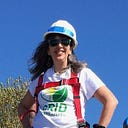Eerie red skies aren’t good for the mood — or for solar production
My predominant feeling on awakening the morning of September 9, 2020 was confusion. I thought it was the middle of the night. The sun didn’t appear to have risen, and an eerie red glow emanated from the sky.
The culprit was a thick but high layer of ashes and smoke from the state’s raging wildfires — which elicited comparisons to Blade Runner and Mordor from the stream of friends who posted photos on Facebook like the one above.
Daylight never made an appearance; it was so dark that we had to keep our lights on all day. This was the day that made climate change more concrete for Bay Area residents. Yes, we’ve known it’s happening — but when what’s normally the most beautiful time of year turns into a post (or during?) apocalyptic hellscape, you can’t help but be deeply affected.
When it was all over, my thoughts turned to how the dark skies might have affected solar production.
Like our neighbors, and many other Californians, we have solar panels on our roof. With large solar farms as well, and 1 million solar roofs, California is the #1 solar state, getting more than 20% of its electricity from solar.
But will the increasingly severe and lengthy wildfire seasons jeopardize the state’s solar status? And what effect did the recent smoky skies have on our solar system production?
The big picture
According to the California Independent Service Operator (CAISO), which manages the state’s electric grid, the ash and smoke decreased solar production by just around 20%. And in the areas where production was lowest, energy demand went down as temperatures dipped and people turned off their air conditioners.
Let’s take a look at the day of orange skies, September 9. Here’s the data from CAISO:
Not so bad, compared to a recent sunny day, September 18:
September 10, while no longer orange, brought a rain of ashes from still-dark skies. Here’s the solar data from that day:
That does indeed look like about a 20% decrease — not bad considering how dark those days were. September 11, still overcast, got a bit lower, but again, solar production didn’t decline drastically:
Our roof
Now, let’s take a look at how the solar panels performed on our roof in North Oakland. Here’s our energy production on September 9 — very low:
We fared a bit better the next day, September 10 — though it was still dark and gloomy:
And things were looking up on September 11, though it was still somewhat overcast:
On the sunny day, September 18, 2020, production was back up:
Obviously, this is much more granular and localized than CAISO’s data, so it gives a good picture of the extent to which solar production can be affected when the smoke and ashes are directly above.
Since I was checking our solar production, I thought I’d compare to similar dates last year (but did not take the extra step of looking up weather conditions then).
September 9, 2019:
September 10, 2019:
September 18, 2019:
It’s good to see that year-over-year, our panels are continuing to produce well. The thick smoke didn’t last long, and our house is not in a high-fire-danger area. Still, this is just one more negative consequence of California’s “new normal” of severe fires every summer.
Originally published at https://www.linkedin.com.
